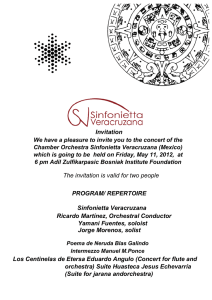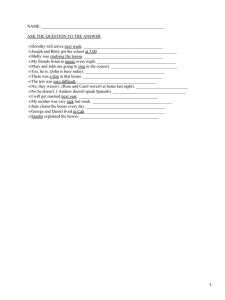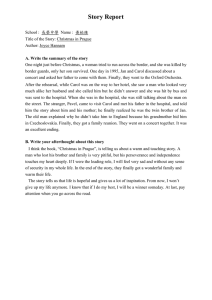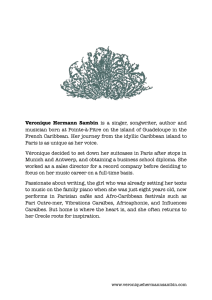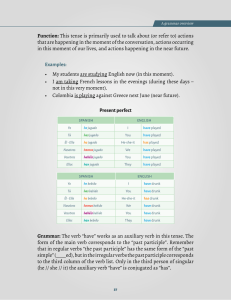Loreena McKennitt in San Francisco
Anuncio
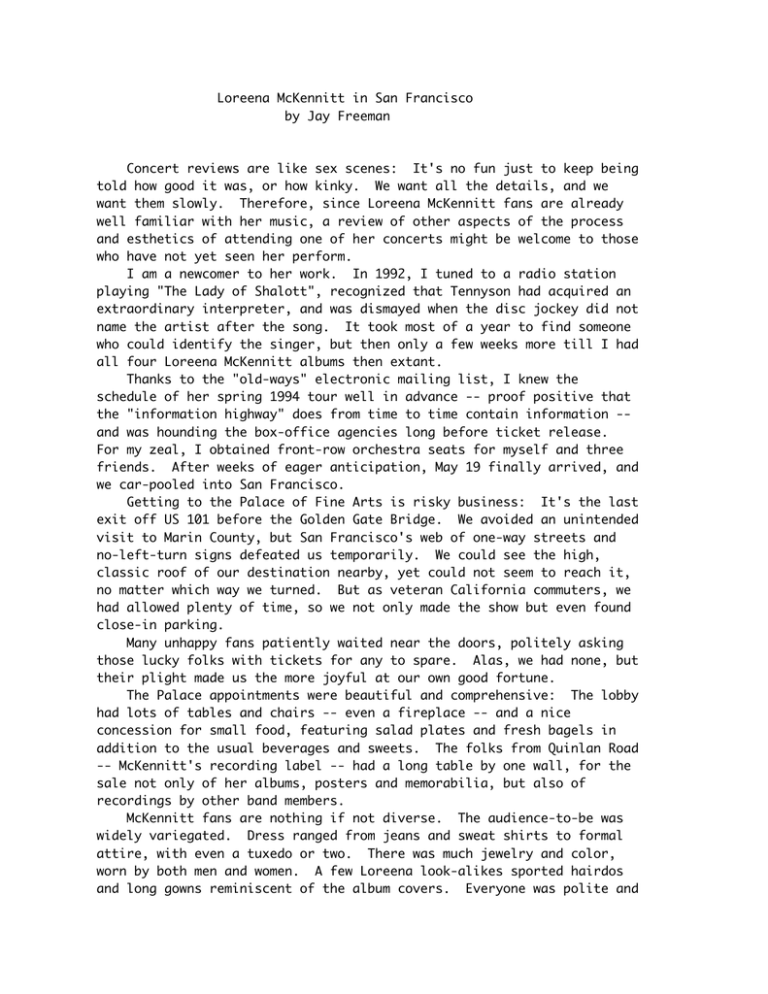
Loreena McKennitt in San Francisco by Jay Freeman Concert reviews are like sex scenes: It's no fun just to keep being told how good it was, or how kinky. We want all the details, and we want them slowly. Therefore, since Loreena McKennitt fans are already well familiar with her music, a review of other aspects of the process and esthetics of attending one of her concerts might be welcome to those who have not yet seen her perform. I am a newcomer to her work. In 1992, I tuned to a radio station playing "The Lady of Shalott", recognized that Tennyson had acquired an extraordinary interpreter, and was dismayed when the disc jockey did not name the artist after the song. It took most of a year to find someone who could identify the singer, but then only a few weeks more till I had all four Loreena McKennitt albums then extant. Thanks to the "old-ways" electronic mailing list, I knew the schedule of her spring 1994 tour well in advance -- proof positive that the "information highway" does from time to time contain information -and was hounding the box-office agencies long before ticket release. For my zeal, I obtained front-row orchestra seats for myself and three friends. After weeks of eager anticipation, May 19 finally arrived, and we car-pooled into San Francisco. Getting to the Palace of Fine Arts is risky business: It's the last exit off US 101 before the Golden Gate Bridge. We avoided an unintended visit to Marin County, but San Francisco's web of one-way streets and no-left-turn signs defeated us temporarily. We could see the high, classic roof of our destination nearby, yet could not seem to reach it, no matter which way we turned. But as veteran California commuters, we had allowed plenty of time, so we not only made the show but even found close-in parking. Many unhappy fans patiently waited near the doors, politely asking those lucky folks with tickets for any to spare. Alas, we had none, but their plight made us the more joyful at our own good fortune. The Palace appointments were beautiful and comprehensive: The lobby had lots of tables and chairs -- even a fireplace -- and a nice concession for small food, featuring salad plates and fresh bagels in addition to the usual beverages and sweets. The folks from Quinlan Road -- McKennitt's recording label -- had a long table by one wall, for the sale not only of her albums, posters and memorabilia, but also of recordings by other band members. McKennitt fans are nothing if not diverse. The audience-to-be was widely variegated. Dress ranged from jeans and sweat shirts to formal attire, with even a tuxedo or two. There was much jewelry and color, worn by both men and women. A few Loreena look-alikes sported hairdos and long gowns reminiscent of the album covers. Everyone was polite and quiet, with no rowdiness to be seen. The inner doors opened on time, and we filed in. The ceiling seemed very far away, and a tremendous stage spanned nearly the full width of the hall. Seating was for live theater, with rows sloping steeply up, to give everyone a view of the stage. Even the most remote seats were close enough to see well. What a treat to be in the front row! The stage edge was close enough to reach out and touch, almost close enough to prop my feet on, though a little high. I did try, though, and one of my companions promptly took off her shoes. The stage itself was empty of performers, and dimly lit. The curtain was open to the band's equipment, set up in tiers. In front, ten or fifteen feet from the edge of the stage, lay McKennitt's harp. At extreme left and right were large speakers. In the next row, starting at the audience's right, were a cello, an electronic keyboard, McKennitt's piano, centered behind the harp, and a guitarist's position with a variety of mysterious instruments half hidden. Further back and higher, again from the right, were the equipment and positions of fiddler, percussionist and bass player. Smaller items of equipment, electronic components, and instrument cases lay here and there. Most of the musical apparatus and fixtures was solemnly black, as was the drapery with which the stage was set. Intermingled among the equipment were tall candelabras, not yet lit, each carrying seven white candles perhaps two inches thick and eighteen tall, regularly arranged in an inverted vee. The candles were not real -- I could not see exactly how they worked -- but their appearance both unlit and lit was close in detail and as perfect in atmosphere as if they were burning wax. They were almost architectural in their contribution to the stage setting. As candles, they suggested the mystery and quiet sanctity of a medieval cathedral, and as an array of stark white columns they hinted at the classic simplicity of a Greek temple. Quiet music played from the huge speakers as the audience settled itself. Presently the lights went slowly low. The performers entered from the wings, briefly using small flashlights carefully to pick their way among the wires and cables, and the concert started. The lights came up slowly, starting with a carefully focused pale blue spot shining straight down on Loreena McKennitt. Its wan, clear light washed her wide hair to the colorless, radiant luminosity of antique silver or a midwinter moon. Her strong, composed face, eyes downcast as she stood before the keyboard, remained quiet as the music began. Her long, covering dress seemed also to glow -- its panels of differing shades and naps of black and dark gray lent greater luster and depth to the rich fall of its folds than if it had been entirely of any one somber hue. She could have been the spirit of another place and time. She could have been a priestess about to perform solemn ritual. And who knows? Perhaps she was. Perhaps she was... The opening number was "The Mystic's Dream", substantially as performed on the new album, "The Mask and Mirror", with what seemed to be the same backing choir vocals, played through the sound system. I think that was the only prerecorded material in the concert. McKennitt's voice, the rich and dynamic soprano heard on all the recent albums, was undeniably and wonderfully real. There was applause, but the audience seemed as much hushed as electrified. I was grinning. Next was "Santiago", from the same album. McKennitt stepped away from the keyboard and took up her accordion for some of the sustained chords in the latter part of the piece. As she played, she moved about the stage, dancing with contained rhythm. The large, glistening pocketwatch hanging from a cord around her neck bobbed and swung in response. She swayed this way and that, lifting first one foot and then the other in time to the music, smiling at the other musicians in the band. She has a delightful smile. Most Americans grin like predators, showing our teeth as if about to pounce. Not so Loreena McKennitt: The corners of her wide mouth spread wider still, then lift slightly upward as she turns her eyes toward the subject of her pleasure, all but beaming, with lips still nearly closed. The whole process is slow enough that the viewer can sense it starting to happen and watch it develop, which is great fun. She thus favored each member of the band regularly, and also from time to time the audience. Third came "She Moved Through The Fair", from the first album, "Elemental". It is not a personal favorite, so although I noticed some differences in style and presentation from the recorded version, they did not strike me sufficiently to remember and describe them. Then McKennitt stopped to talk for a while. She joked about not having left her harp in San Francisco, and introduced her band: Brian Hughes played guitars and another strummed instrument called an "oud", Rick Lazar did all manner of percussion, Steve Lucas played acoustic bass, Hugh Marsh fiddled, and cellist Kiki Misumi also doubled at the keyboard occasionally, when McKennitt was not using it. They all wore conservatively-cut clothing in grays and blacks, matching the general style of McKennitt's dress. The various compositions gave every musician a time as the dominant force in the music. McKennitt was careful to use gaze and posture to direct the audience's attention to her colleagues at such moments, as well as to express her verbal appreciation of their talents. She described them as "idling Porsches", whose roles provided no opportunity to show the full scope of their virtuosity. Hughes and Marsh subsequently got to do compositions of their own, which demonstrated that they were Porsches indeed, but I am getting ahead of myself. About then I realized that McKennitt seemed very tired. I am still not sure what combination of expression and body language made me think so, but I had that impression strongly, and it appeared confirmed now and then during the performance, when some of her comments to the audience got a little disjointed. The band was near the end of some two months of tour, both in Europe and in North America, so fatigue is understandable. Yet they had had a six-day break since their last date, in Washington, DC, and McKennitt spoke happily of soaking up heat in Arizona, evidently en route to the west coast, so it is not as if there had been no relief. I hope she was well. Next was "Between The Shadows", a short instrumental from "The Visit", followed by two Yeats settings: "The Two Trees", from "The Mask and Mirror", and "The Stolen Child", from "Elemental". The latter work is one of my favorites, so I was most attentive to how the concert version differed from the 1985 recording. The change was dramatic: In the earlier work her voice was a more fluid, almost throaty soprano, but on stage in 1994, she gave a vocal presentation in the drier and more expressive voice of the recorded versions of "Full Circle" or "Greensleeves". I would welcome a new recording of "The Stolen Child" in this style, and while I am on the subject of Yeats settings, I do wish she would try "The Song of Wandering Aengus", too. As McKennitt moved from instrument to instrument, and the mood of the music changed from one composition to another, the lighting crew used more narrowly focused spotlights with different filters completely to change the color of her hair. During the romantic pieces that tell of love given or love lost, they generally brought it to a tone warm as a new-polished penny or a pale alloy of gold. Since there was nothing remotely resembling natural lighting anywhere on stage, I have little idea what color her hair actually was. My best guess, based on hints seen in the flashlights used for walk-on and walk-off, would have it a pale straw blonde, a little lighter than on the cover portrait for "The Mask and Mirror", but there was not enough light to be sure. Next, Brian Hughes got to strut his stuff with "Nasca Lines", an instrumental from his recording, "Under One Sky". I know little about the instruments a guitarist plays, so cannot provide details of his talents, but they were considerable, for the piece is fast and intricate. His playing was most expressive, and fun to watch. The instruments Hughes used throughout the concert were varied and fascinating, often richly and unconventionally detailed. I wished he had set them on stands where the audience could see more of them. The first set finished with "Full Circle", from "The Mask and Mirror". The presentation was close to the recording, but with additional high-pitched tones during the introduction, which I think enhanced the feeling of open space and desert that the work suggests. Several of my companions felt the intermission more interruption than respite. We stood by our seats, looking for friends in the audience and finding many, or chatting familiarly with the occupants of seats nearby, who seemed no longer strangers. We had been brought together by our common love of the music and by the transforming strength of the performance. And soon the lights dimmed again. The first piece in the second half was an electronically augmented violin instrumental of "Amazing Grace", by Hugh Marsh, available at the door on a tape cassette bearing only his name for identification. It was fabulous! Marsh made his fiddle sound like everything from a human voice to a complete percussion set. We already knew the violin was an erotic instrument, but that was kinky! I suspect Marsh's fiddle was a talking drum in a previous life. Next came two more selections from "The Mask and Mirror", namely "The Dark Night of the Soul" and "Marrakesh Night Market", again not much different from the album. When circumstances permitted, as when another musician played or her own passage was simple, McKennitt seemed to enjoy making eye contact with her audience. The stage was not bright and the footlights seemed low, so she could probably see us well. She spent fifteen seconds or so looking curiously in my direction. I am in no way a remarkable sight, but I have read that McKennitt likes to garden: I think she was looking at the wild white roses I had tucked into my shirt pocket, where they stood out in sharp contrast to the forest-green fabric. Next came "Bonny Portmore", from "The Visit", which is my favorite song in her repertoire to date. I was on the edge of my chair in anticipation, but the arrangement was different than on the album, though interesting in its own right, and the high notes were not so sustained and powerful. I was a little surprised when I glanced along the front row and found that I was the only person sitting forward. Suddenly curious about others' reactions, I looked around regularly during the rest of the concert, and found remarkable variation in response: Here and there people were in tears, and occasionally a few folks seemed in trance. Nobody was asleep. Another Brian Hughes instrumental followed: "Procession", which appears not to be on any album. Then came the one song most of us had been waiting for, from "The Visit", "The Lady of Shalott". I enjoyed watching McKennitt play harp. She kept the instrument to her right, and from my seat nearly in front of it I had a greatly foreshortened view of that side of the instrument, so that I could see the intensity of her gaze and the strength and precision of her hands as she plucked and strummed the strings, even as I listened to the free and ethereal melody that resulted. Music has never been my art, but the dichotomy between exactness of implementation and apparent freedom of result occurs in many other practices, artistic and technical alike. To see it in McKennitt's musical craft was humbling, for her creativity so far exceeds my own, yet also encouraging, in that an experience known to masters can be shared by apprentices and journeymen. But she muffed "The Lady of Shalott"! She dropped the two verses before the last, in the one piece no doubt best known to most of her audience. For a moment I thought it a deliberate rearrangement, or an accommodation to the strain of two hours' singing. (And how frustrating it must be when your fans know all your stuff and complain if you change it the least bit.) It may have been, but on reflection, I think it was simply a mistake. For a few seconds, her face looked all too much like the expressions of my cats on entering a room where I have just rearranged the furniture. But it was all right -- the strength and integrity of the performance carried us, as it carried her. And perhaps a master's error will provide some shred of enlightenment to those who use their own errors as justification for not attempting mastery... The last two numbers were both as on "The Mask and Mirror": "The Bonny Swans" and "Prospero's Speech". The standing ovation was immediate and enthusiastic. The entire band came back and did a "Huron Beltane Fire Dance" that was longer, wilder and even more powerful than the one on "Parallel Dreams", and all but had us jumping up and down and screaming. They got another standing ovation, and then she returned alone, took up her harp at the front of the stage, and played the achingly beautiful "Annachie Gordon", again from "Parallel Dreams". And a third standing ovation notwithstanding, our last dream of the evening was the narrow, vertical spot beam slowly fading, fading, till all that remained of the bard was the luminous afterimage of her hair. Loreena McKennitt has publicly discussed the motivations for her artistic path. My summary would be that she is on a musical quest for the wellsprings of the spiritual side of human nature, a journey in pursuit of those aspects of our character and condition that make religion and mysticism possible: A search for the song where the soul was born. I do not doubt she is a successful entrepreneur who properly responds to the wishes of her public, yet I believe she speaks truly, for the majority of her recorded work, and nearly all of the more recent material, touches on some such theme as I have mentioned. A concert by such an artist is not just a commercial event, or even just an aesthetic one. It is an act of intimacy and of learning, with an underlying structure beyond the mere sequence of songs. The soft lighting, the meaning-laden props, the formal costumes, and the subdued colors, all lead up to the introductory invocation of a "Mystic's Dream", in which we are transformed and unified. We are changed from an unrelated group of urbane citizens of a hasty and shallow civilization, into a closely-knit community of seekers after truth. We find that we have come to discover and experience what another voyager has found along the way, and what it meant, and whether it mattered, and why it was important to her. Perhaps it will be important to us as well, if only she has the skill to lead us where she has already gone. Loreena McKennitt has that skill. Her concert combines the power and tradition of the entire human ritual process, resynthesized from long-separated aspects found in theater, in musical performance, and in religious ceremony. She uses lighting, props, costume, and gesture, effectively to augment the mixture. The result is something at once very old and very new, or at least very rare in the modern world. And it works: Its strength is measured by the intensity of emotional response of the audience, and by the continued eagerness and enthusiasm of her fans. With the end of the prepared program, the words of Prospero bid us return to a more conventional reality. Yet the sudden vast force of the first encore leaves a full memory of the things that we have been led to know, with a sense they are there for us to find again, that they will come back if we but choose to look for them. And the second encore, done privately at the front of the stage, reminds us that Loreena McKennitt is also still there, and that she, too, may yet come back. I hope so. Jay Freeman Palo Alto May 26, 1994
